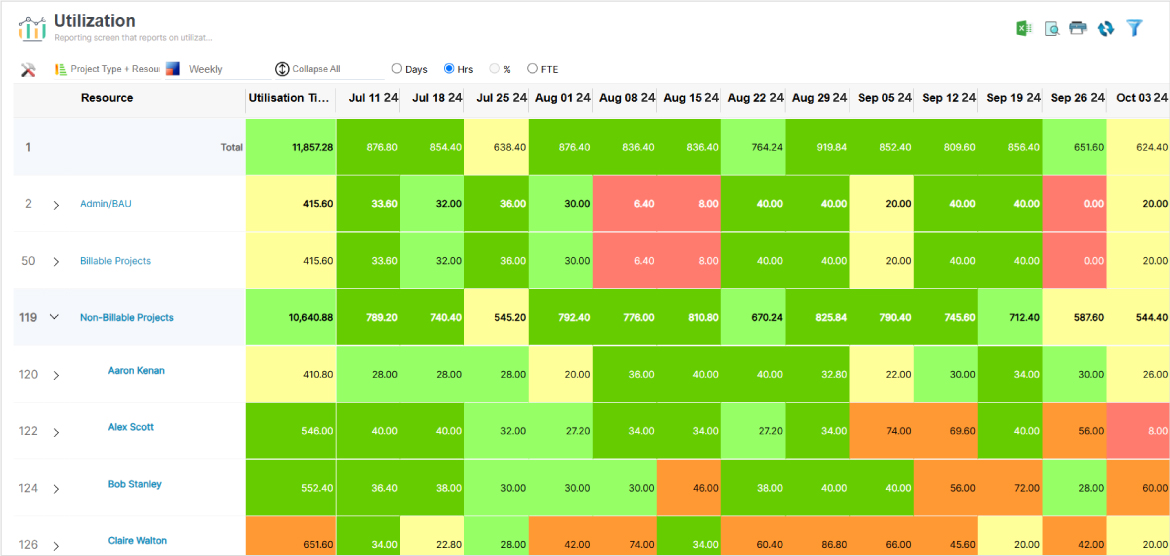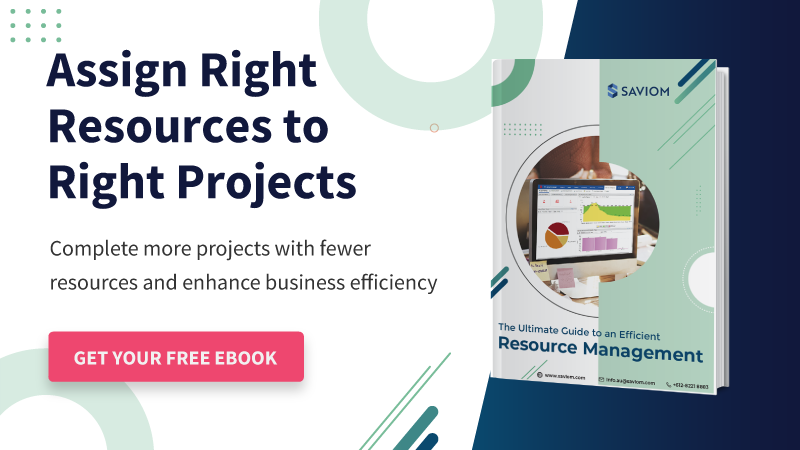According to a PMI survey, “the two primary causes of the project failure are limited resources and resource dependency, constituting 21% and 26%, respectively”.
Regardless of project size and complexity, resource constraints often emerge as the most significant barrier to project success.
These constraints include skill gaps, resource shortages, sub-optimal utilization, sudden absence of critical members or attrition, burnout, and more. If left unaddressed, it can lead to a project coming to an abrupt halt or even failing.
Therefore, it is crucial for firms to proactively identify and manage these risks in time to ensure favorable business outcomes.
This blog helps deep dive into the various resource constraints and effective strategies firms can adopt to tackle them promptly.
But let’s first understand what a resource constraint is.
What are Resource Constraints?
Resource constraints refer to the limitations in the timely availability of the workforce, finances, materials, etc., that can delay or disrupt project initiation and progress.This can ultimately lead to a missed deadline, sub-par outcomes, disgruntled stakeholders, ultimately damaging organizational reputation and credibility.
Let us now dive straight into a few examples of resource constraints.
Common Resource Constraints Examples
Projects often face various resource-related constraints that can hinder progress and impact outcomes. Read on:
Workforce Constraints
Workforce constraints refer to the unavailability of competent resources when needed for a project, often due to factors such as talent shortages, unplanned leaves, sub-optimal utilization, etc. These constraints can result in cost overruns, missed deadlines, client dissatisfaction, etc.
Below are some basic resource constraints examples-
- Skill Gaps & Talent Mismatches
Skill gaps or talent mismatches refer to a lack of alignment between employee skills, competencies, capabilities, etc., to the organizational projects. This disparity can reduce resource productivity, increase costs, and jeopardize timely project delivery.
- Resource Shortages
Resource shortages refer to a lack of available resources to meet project needs adequately. This can lead to last-minute firefighting for competent resources, delayed project initiation, sub-par project deliverables, etc.
- Unforeseen Absences
Unforeseen/unplanned absences occur when employees miss work without prior approval, often due to illness, family emergencies, or personal matters. This can disrupt dependent tasks, hinder project progress and overall delivery
Read More: What is Leave Management, and Why is it Important for Successful Project Delivery?
- Unplanned Attrition
Unplanned attrition refers to the unexpected departure of employees from the organization without prior notice. This can lead to overburdening existing resources, decreased productivity, compromised project quality, etc.
Read More: 9 Effective Employee Retention Strategies for Your Workforce
- Sub-optimal Utilization
When critical resources are not utilized to their full potential and are instead deployed on BAU, admin, or other non-billable tasks, it leads to sub-optimal utilization. This can cause staff disengagement, reduced productivity, etc. - Employee Burnout
When the staff is persistently deployed to projects beyond their capacity for a prolonged period, it causes employee burnout. This can overwhelm and stress the workforce, leading to exhaustion and unplanned attrition.
Time Constraints
Time constraints refer to a fixed deadline or predetermined timeframe within which tasks/projects must be completed. This imposes a non-negotiable deadline, and any delays could result in missed market opportunities and reduced revenue potential.
Read More: Time Management: How It Is Important for Project Delivery
Cost Constraints
Cost constraints refer to the financial limits imposed by factors like employee cost rates, equipment expenses, maintenance costs, etc., on the project budget. If not managed effectively, it may inflate costs, reduce project margins, and risk the business’s overall success.
Material Constraints
Material constraints refer to the unavailability or limitations of essential equipment, raw materials, or supplies for the project. These constraints, if not managed effectively, can hinder progress, compromise the quality of the work, or delay the project schedule.
Now that we clearly understand the various types of resource constraints with examples, let’s explore practical strategies for managing them.
How to Manage Resource Constraints?
Identifying and managing resource constraints throughout the project lifecycle is essential to achieve optimal outcomes. Here are some strategies to combat these resource-specific challenges:
Identify Gaps & Provide Appropriate Training
In today’s fast-paced business landscape, rapid technological advancements and continuous innovation have become the norm. Staying abreast of these evolving demands is crucial for maintaining a competitive edge. Failure to adapt can result in widening skill gaps, compromised project delivery, and missed growth opportunities.
Thus, firms must continuously monitor emerging trends and assess their workforce’s competency matrix to identify skill gaps and areas for improvement. Accordingly, managers can implement tailored training initiatives such as job rotation, shadowing, reskilling/upskilling, etc., to create a future-ready workforce, boost productivity, and enhance overall performance.
Read More: Importance of Skill Development in Making Your Workforce Future-Ready
Foresee and Bridge Demand Gaps
When organizations focus solely on meeting immediate resource needs, they may fail to plan for future opportunities accurately. As a result, when critical projects arise, they face resource shortages and resort to last-minute scrambling for skilled talent. This reactive approach increases costs, lowers productivity, compromises project quality, etc.
To prevent such setbacks, managers must proactively perform capacity vs. demand analysis well in advance. In case of discrepancies, they can implement appropriate resourcing measures such as upskilling, retraining, out-rotation/backfilling, or hiring to effectively bridge the demand gaps and build a competent talent pool.

SAVIOM’s real-time capacity vs. demand report helps managers foresee resource shortages or surpluses ahead of the curve
Create a Backup for Critical Resources
Niche-skilled resources possess specialized knowledge and expertise essential to driving key projects, meeting client expectations, and maintaining operational efficiency. Thus, when these key employees take a sudden leave, it can disrupt ongoing projects and compromise deliverables.
To avoid this, managers should identify critical roles and proactively prepare internal backups. This strategy reduces over-reliance on a few key resources, ensures business continuity, and enhances the organization’s ability to take on complex projects, ultimately boosting revenue growth.
Facilitate Succession Planning for High-Performing Individuals
When key resources leave an organization, it often results in a significant loss of skills and expertise, which can halt critical projects and negatively impact profitability. To mitigate this resource risk, businesses must always be prepared with a well-defined succession plan in place.
Managers can initiate succession planning by identifying and grooming high-performing individuals within the workforce to take on key roles. This approach helps cultivate a new generation of leaders, and ensures seamless business continuity, enhanced project outcomes, and consistent cash flow.
Read More: What is Workforce Planning, and How to Master it for Business Efficiency?
Track and Maximize Resource Utilization
Effective workload distribution is essential for ensuring smooth project progression and timely delivery, directly contributing to business productivity. Without it, organizations face inflated costs, disengaged workforce, low employee morale, and compromised project outcomes.
To prevent these issues, managers must continuously track how employees allocate their time across billable, strategic, and non-billable tasks in real time. This insight enables managers to reduce time spent on non-billable work and reassign employees to high-priority, billable projects, thereby maximizing resource productivity.

SAVIOM’s advanced resource utilization reports and color-coded heatmaps help managers optimize the workforce productivity levels with ease
Apply Suitable Optimization Techniques
Managers often assign tasks to employees without assessing their available capacity, leading to resource overutilization. Further, when a resource excels at a task, they may be repeatedly assigned more work, causing stress and burnout over time. To prevent this, organizations can leverage suitable optimization techniques to manage workloads better.
For instance, for flexible projects, managers can apply resource leveling techniques to adjust the start and end dates to balance resource allocation. Alternatively, for projects with fixed timelines, they can implement resource smoothing to redistribute workloads or pull in extra resources to meet deadlines without overloading key personnel and increasing productivity.
Read More: What is Resource Optimization? A Complete Guide to Improve Project Delivery
Prioritize Tasks Based on Business Objectives
Effectively managing time constraints is crucial for ensuring that key priorities are met without compromising project quality. Without this focus, managers may inadvertently prioritize low-priority tasks, miss critical deadlines, or deliver sub-par work.
Therefore, firms must align tasks with core business objectives to ensure resources are directed towards high-impact activities. This helps achieve key goals efficiently, optimizes resource utilization, boosts organizational performance, and delivers greater value.
Monitor Key Financial Indicators Consistently
Key metrics, such as revenue, net income, profit margins, etc., are essential for gauging the financial health of any organization. By tracking these indicators regularly, businesses can stay informed and make data-driven decisions to regulate project costs effectively.
Additionally, to further enhance their cost control measures, managers can forecast and compare the actual spending against the estimated project budget. This proactive approach allows them to implement strategies like creating a cost-effective resource mix, ensuring expenses stay aligned with financial goals, and driving better ROI.
Now that we know how to manage various resource constraints, let us understand how modern resource management software helps overcome them.
How Does Resource Management Software Help Overcome These Constraints?
Resources are the critical assets that drive the project to success. Thus, businesses need to ensure they keep performing at their best. Saviom’s robust resource management tool provides actionable insights into real-time data and helps companies optimize project performance and maximize the ROI. Here’s how:
- The tool offers 360-degree visibility into resources within the enterprise and helps examine critical attributes such as competencies, skills, location, etc., allowing managers to select the right resources for projects.
- Its resource forecasting and capacity planning feature helps identify and bridge the capacity vs. demand gap ahead of time to create a competent resource pool.
- Additionally, resource utilization reports and color-coded heatmaps enable managers to identify over or under-utilization of critical resources and optimize the workload.
- Further, the people-on-the-bench reports help predict when a resource will hit the bench. Accordingly, managers can leverage the project vacancy reports to schedule them for future projects and reduce the bench time of resources between projects.
- The tool’s timesheet tracker functionality allows resources to apply for leave in advance, enabling managers to formulate a backup plan and find a substitute for the employees on leave.
- Finally, the modeling and simulation feature (what-if analysis) helps managers create multiple scenarios by adjusting key metrics to identify the best possible outcome within the given resource constraints.
Over to You
“Embrace your constraints,” said Cristopher Isaac Stone, popular as “Biz” Stone, the co-founder of Twitter.
The same applies to resource managers. By adopting the aforementioned strategies, coupled with the right resource management tool, managers can effectively offset resource constraints, seamlessly streamline project workflows, and yield better business outcomes.
So, have you devised a solid plan to overcome resource constraints?
The Glossary
Read More: Glossary of Resource Workforce Planning, Scheduling and Management












